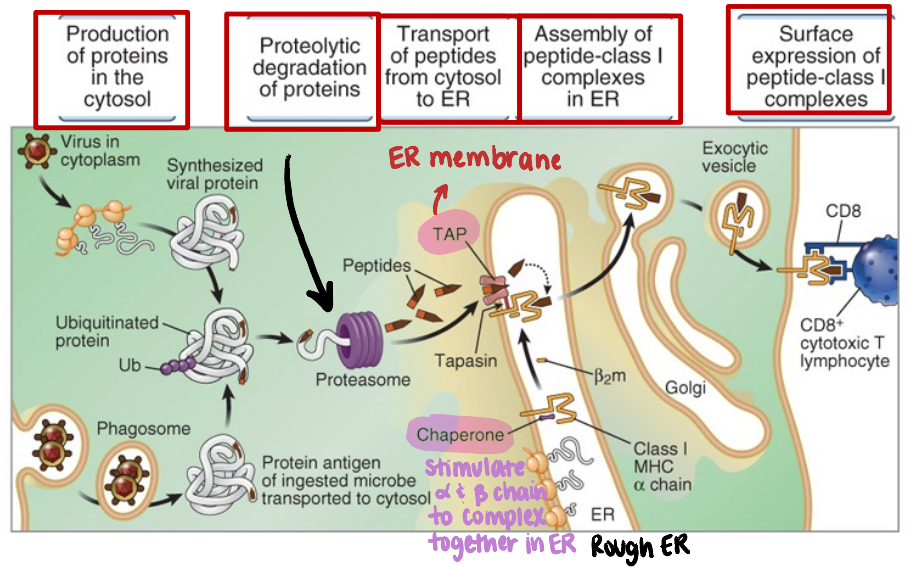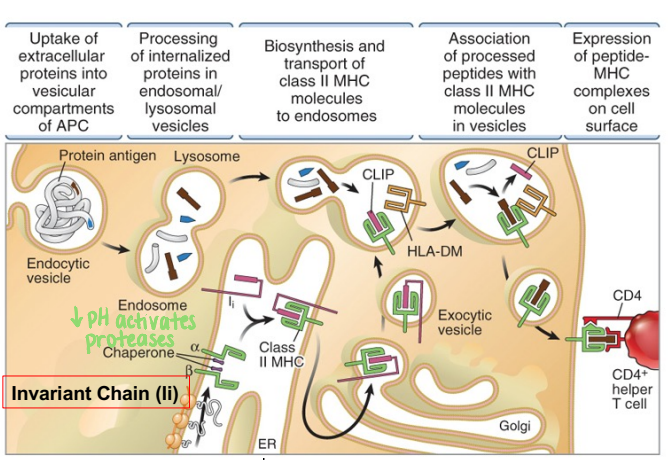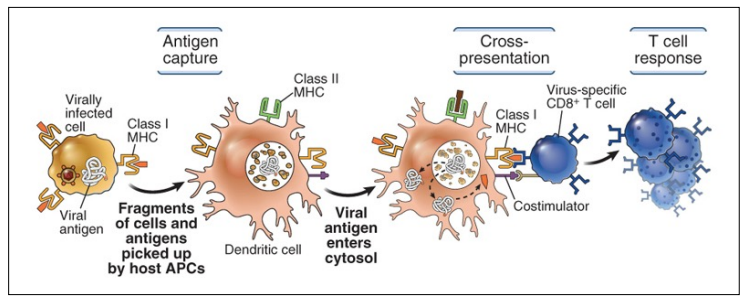12. antigen processing & presentation to T lymphocytes
1/26
There's no tags or description
Looks like no tags are added yet.
Name | Mastery | Learn | Test | Matching | Spaced |
|---|
No study sessions yet.
27 Terms
where does antigen presentation occur during the initiation of T cell responses?
secondary lymphoid tissues (spleen, lymph nodes) to naive T cells
where does antigen presentation to effector T cells occur?
can occur in all tissues
antigen presentation by migratory dendritic cells
antigens are captured by dendritic cells → become activated
dendritic cells migrate to paracortex (lymph nodes)
present antigen to naive T cell
vesicular cellular compartment
membrane-bound organelles (separated by membranes)
communicates with extracellular environment → endo/exocytosis
ex. golgi, endosomes, lysosomes
cytosolic cellular compartment
communicates intracellularly → between nucleus & cytoplasm
what two important factors regulate the pathway of antigen processing & presentation?
source of proteins
extracellular
intracellular
intracellular location of the protein
endosomes
cytoplasm
extracellular/vesicular antigens are processed by what pathway?
exogenous/endocytic pathway - MHC II (presented to CD4+ cells)
endocytosis of extracellular foreign protein antigen
what type of vaccines utilize the exogenous/endocytic pathway?
inactivated or purified protein vaccines
cytosolic antigens are processed by what pathway?
endogenous/cytosolic pathway - MHC I (presented to CD8+ cells)
endogenous synthesis of foreign protein antigen (ex. viruses, listeria, mRNA)
what types of vaccines utilize the endogenous/cytosolic pathway?
live viral/vectored vaccines
mRNA vaccines
what is cross presentation?
extracellular protein processed through the endogenous/cytosolic pathway → MHC I → present to CD8+ cells
what cells can cross-present?
dendritic cells only
which cells can present antigen to CD8+ T cells?
all nucleated cells (express MHC I)
ubiquitin
when conjugated to other proteins, flags protein for degradation
proteasome
filled with proteases → cytosolic proteolysis
MHC I (endogenous/cytosolic) pathway general steps
production of proteins (ex. viral proteins) in cytosol
proteolytic degradation of ubiquinitinated proteins (via proteasome in cytosol)
peptides transported from cytosol to rough ER (TAP1 & 2)
complexes with MHC I in the ER
peptide-MHC complex packaged into exocytic vesicles and expressed on surface

what do chaperone proteins do?
stimulate α and β chains of MHC molecules to complex together in ER
transporters associated with antigen processing (TAP) - TAP1 & TAP2
translocate peptides from cytoplasm into ER for loading onto MHC class I molecules (located in ER membrane)
what is the physiological significance of MHC I-associated antigen presentation?
cell killing by CD8+ cytotoxic T lymphocytes
what cells can present antigens to CD4+ T cells?
professional antigen presenting cells
dendritic cells
macrophages
B cells
why can professional antigen presenting cells present to CD4+ cells?
express MHC II molecules
ability to perform endocytosis
ability to process endocytosed antigens
(can internalize & process extracellular proteins)
MHC II (exogenous/endocytic) pathway general steps
uptake of extracellular proteins into vesicular compartments
proteins broken down by proteases in endosome
MHCII transported from ER to endosome
proteolytic degradation of invariant chain & CLIP removal
peptide-MHC interaction in endosome
expression on cell surface

invariant chain
binds to MHC II & blocks peptide binding groove → prevents peptide loading onto class II molecules in ER
involved in trafficking of MHC molecules to peptide-containing acidified endosomes
class II-associated invariant chain peptide (CLIP)
piece of invariant chain that remains in peptide binding groove after proteolytic degradation
HLA-DM
catalyzes removal of CLIP from peptide binding groove to allow peptide loading onto MHC II molecule (in endosome)
what is the physiological significance of MHC II-associated antigen presentation?
immune response against extracellular pathogens
production of antibodies
B cells present peptide-MHC complex to T cells → T cells help B cells produce Abs
what is the physiologic significance of cross presentation?
DCs can present microbial/tumor antigens from infected/neoplastic cells to CD8+ cells → prime CD8+ T cells to target infected/neoplastic cells
